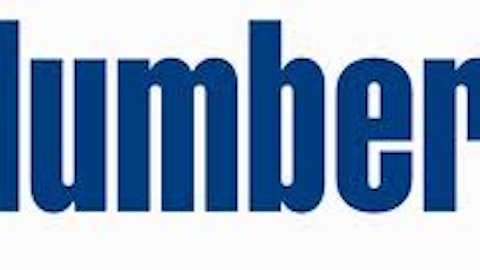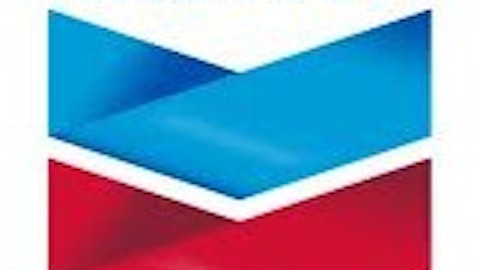I don’t own any stocks which are related to energy. The big oil companies are so big that growth is slow and valuations are often higher than I’d like to pay. They’re fine dividend stocks, but not exactly value stocks. On the other hand, small oil and gas exploration companies are often far too speculative for me to take seriously. But I realized recently that instead of looking at the companies that actually produce the oil and gas I should instead look at the companies which supply the equipment to do so.
It’s kind of like the PC market, where actual manufacturers of PCs saw their margins dry up as competition grew intense while companies like Intel Corporation (NASDAQ:INTC) and Microsoft Corporation (NASDAQ:MSFT) made a killing. In the energy business, National-Oilwell Varco, Inc. (NYSE:NOV) fills that role.
No other vendor
National-Oilwell Varco, Inc. (NYSE:NOV), both the company’s stock symbol and an acronym for its nickname “no other vendor”, maintains a dominant share in the global rig market. I won’t pretend that I know all that much about the details of oil rigs and their operation, but NOV sells just about everything involved.
NOV has increased it’s annual revenue by a factor of 10 since 2003, largely through an aggressive strategy of acquisitions. From 2008 through the first quarter of 2013 the company spent $9.6 billion in acquisitions, and during that time annual revenue increased from $13.4 billion to $20 billion. National-Oilwell Varco, Inc. (NYSE:NOV) acquires companies in order to expand its product line into new areas and regions, increasingly becoming a one-stop-shop for customers. In the first quarter of 2013 NOV completed a $2.5 billion acquisition of Robbins and Myer’s, the largest single acquisition in four years.
Where’s the debt?
It would be reasonable to assume that a company like National-Oilwell Varco, Inc. (NYSE:NOV) which spends so much on acquisitions would rack up an enormous amount of debt. Reasonable, but incorrect. Until the Robbins and Myer’s deal NOV had very little debt, and the most recent figure puts the total debt at $4.35 billion. The company has $2.84 billion in cash and investments, leaving $1.51 billion in net debt. Previous to the end of 2012 the company actually had a net cash position, but its latest acquisition required National-Oilwell Varco, Inc. (NYSE:NOV) to take on more debt.
The acquisitions of the past five years have been funded by the company’s strong cash flow. The average annual free cash flow over the past five years is $1.35 billion, although the 2012 number is negatively skewed by big changes in working capital. This means that the entire net debt position could nearly be eliminated in a with a single year’s free cash flow.
A look at profitability
The financial crisis caused a drop in revenue and a steep drop in earnings in 2009 as the total rig count fell amidst the recession. Both have recovered, though, with revenue growing by 36% in 2012 and EPS growing by 24%. For valuation purposes I like to look at owner earnings, which is a modification of the free cash flow which eliminates the items which have nothing to do with operational profit. Here are the owner earnings for the past five years:
| Year | Owner Earnings (billions USD) | Owner Earnings/Share |
|---|---|---|
| 2012 | $2.59 | $6.07 |
| 2011 | $2.10 | $4.95 |
| 2010 | $2.04 | $4.87 |
| 2009 | $1.80 | $4.32 |
| 2008 | $2.06 | $5.16 |
Even during the recession National-Oilwell Varco, Inc. (NYSE:NOV) made plenty of profit, and since then owner earnings have surpassed pre-recession highs.
How much is NOV worth?
With $3.53 per share in net debt and $6.07 per share in 2012 owner earnings the company currently trades at an adjusted P/OE ratio of about 12.2. Let’s lay out three growth scenarios and see how much NOV is worth in each one:
Slow growth – Owner earnings per share grow by 6% annually for the next 10 years and by 3% annually after that.
Fast growth – Owner earnings per share grow by 9% annually for the next 10 years and by 3% annually after that.
Faster growth – Owner earnings per share grow by 12% annually for the next 10 years and by 3% annually after that.
I’ll do a simple discounted cash flow calculation to value a share of NOV under these three scenarios. I’ll use a discount rate of both 12% and 15% to define a fair value range. Here are the results:
| Scenario | Low-end | High-end |
|---|---|---|
| Slow growth | $59.38 | $81.93 |
| Fast growth | $72.70 | $101.86 |
| Faster growth | $89.11 | $126.64 |
The stock currently trades at about $70 per share, so it’s within the slow-growth range and below both the fast-growth and faster-growth ranges. The average analyst estimate for 5-year annual earnings growth is 14.33%, well above even my most optimistic scenario. If the analysts are currect then NOV is seriously undervalued. If NOV grows slowly instead the stock is at worst fairly valued.
The big question is: how fast will National-Oilwell Varco, Inc. (NYSE:NOV) be able to grow its earnings? There are two factors which will drive NOV’s earnings forward. First, the company will likely continue its policy of making acquisitions. With a strong cash flow the company could spend $2 billion per year on acquisitions without adding any more debt. Second, growth in drilling rigs will drive organic growth for the company. NOV’s equipment is used not just for drilling oil but for all types of drilling, meaning that the company will benefit from an increase in natural gas production.
The company’s backlog, which measures the value of orders which have been received but not yet filled, is at an all time high. The backlog sat at $11.9 billion at the end of 2012, up from $10.2 billion the year before. This could suggest that the company is poised for strong performance. First quarter earnings came in under analyst estimates but the backlog grew to $12.92 billion, reflecting strong demand for NOV’s products.
I think that the fast-growth scenario is reasonable, and under that scenario the stock is at the very bottom of my fair value range. There’s a real chance that this scenario proves too pessimistic and that the stock is worth a lot more, but it’s better to be overly pessimistic than overly optimistic when it comes to valuation. The stock could reasonably trade at $100 per share today.
Any cheaper options?
NOV appears to be the cheapest oil equipment stock available. Competitor Cameron International Corporation (NYSE:CAM) trades at 26.8 times owner earnings, adjusting for the net debt. Cameron International Corporation (NYSE:CAM) is a smaller company, with less than half the revenue of NOV and far lower margins. Cameron International Corporation (NYSE:CAM)’s operating margin in 2012 was 11% compared to National-Oilwell Varco, Inc. (NYSE:NOV)’s 17.7%. Schlumberger Limited. (NYSE:SLB), a large oil services company, also trades at about 26 times adjusted owner earnings. In both Cameron’s and Schlumberger Limited. (NYSE:SLB)’s cases owner earnings are significantly lower than the net income. NOV has a higher operating margin than Schlumberger Limited. (NYSE:SLB) as well, 17.7% compared to 17%.
The bottom line
National Oilwell Varco looks like a compelling investment opportunity. It’s on my list of stocks to consider buying, and it should be on yours too. It’s a play on oil and natural gas without betting directly on either one, and the stock is undervalued under all but the most pessimistic of scenarios. The stock traded as low as $64 per share earlier this year, which would have been a steal, but at $71 it still offers value.
The article One Cheap Energy Stock to Buy originally appeared on Fool.com and is written by Timothy Green.
Timothy Green has no position in any stocks mentioned, but may buy shares of National Oilwell Varco within the next month. The Motley Fool recommends National Oilwell Varco. The Motley Fool owns shares of National Oilwell Varco. Timothy is a member of The Motley Fool Blog Network — entries represent the personal opinion of the blogger and are not formally edited.
Copyright © 1995 – 2013 The Motley Fool, LLC. All rights reserved. The Motley Fool has a disclosure policy.




